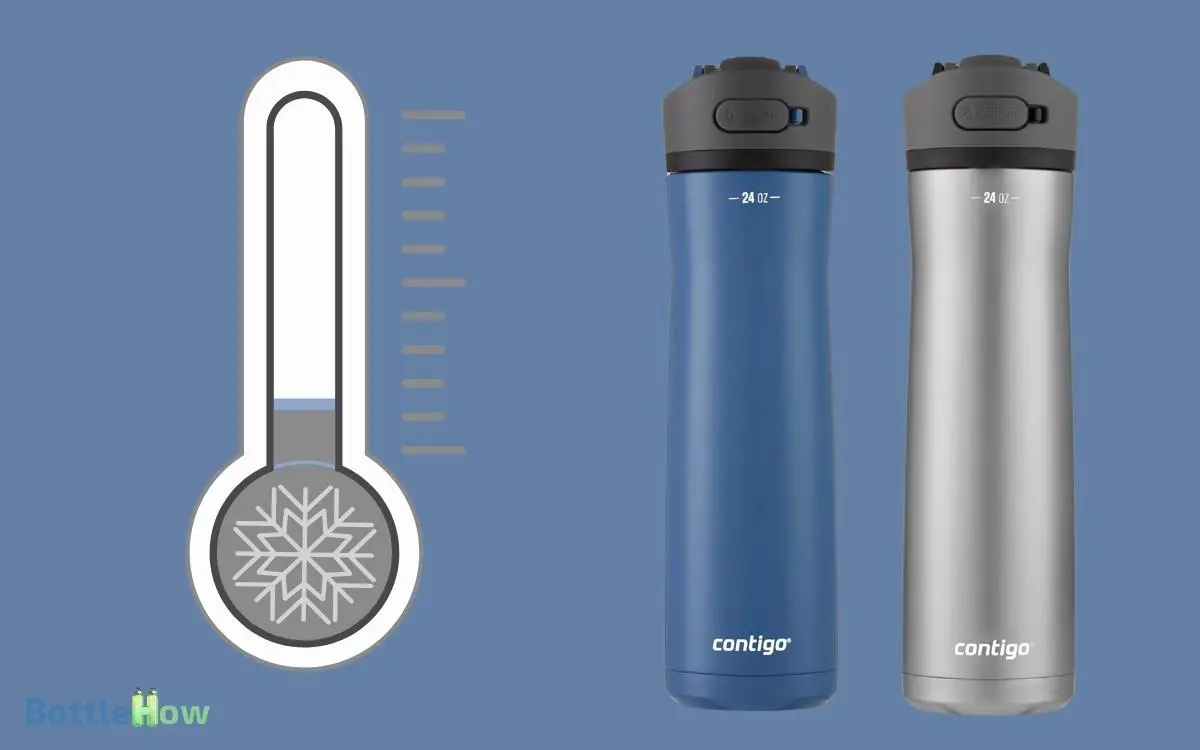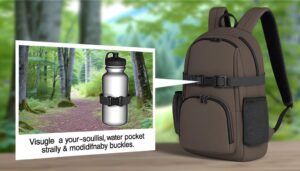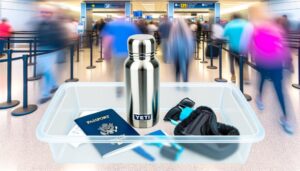Can You Freeze Contigo Water Bottle? Yes!
You can freeze a Contigo water bottle, but it’s risky. Water expands by about 9% when it freezes, potentially causing the bottle to crack or lose its seal integrity.
Plastic parts might become brittle, while stainless steel may handle freezing better but still poses risks. To minimize damage, fill the bottle only three-quarters full and remove the lid before freezing.
Allow it to thaw upright in the fridge and clean thoroughly afterward. Always check the manufacturer’s guidelines for specific care instructions.
Want to guarantee your bottle remains in top condition? There’s more valuable info to explore.

Key Takeaways
Freezing Basics
Understanding the fundamental principles of freezing helps you ascertain whether your Contigo water bottle can safely be placed in the freezer. Water expands as it freezes, which can create pressure inside a sealed container and potentially cause it to crack or warp. If you’re wondering, can you freeze a water bottle, it’s important to check whether the material is freezer-safe to avoid damage. Some bottles are designed to withstand freezing temperatures, while others may not be suitable for such conditions.
Freezing involves reducing the temperature of a liquid until it solidifies. When water freezes, it expands by about 9%, which can exert significant pressure on its container.
If the container isn’t designed to accommodate this expansion, it may crack or break. Freezing also slows down molecular movement, which affects the structural integrity of materials.
Understanding these scientific basics is essential for evaluating the risks associated with freezing any liquid in a container like a Contigo water bottle.
Keep these principles in mind to make sure that you’re making a safe and informed decision about freezing your bottle.
Material Considerations
When considering freezing a Contigo water bottle, you need to evaluate the material’s durability, particularly if it’s plastic, which can become brittle at low temperatures.
Stainless steel bottles may react differently, potentially affecting the liquid’s freezing process and bottle integrity.
Additionally, the bottle’s insulation properties can greatly impact how the freezing process occurs and the time required.
Plastic Durability Factors
The longevity of the plastic in Contigo water bottles hinges on its ability to withstand extreme temperatures without compromising structural integrity. When you freeze plastic, it can become brittle and more prone to cracking.
Contigo bottles are typically made from Tritan plastic, known for its toughness and resistance to impact. However, even durable plastics like Tritan have limits.
Prolonged exposure to freezing temperatures can create stress points in the material, leading to potential fractures when the bottle is dropped or subjected to pressure.
To guarantee the longevity of your Contigo bottle, avoid freezing it entirely. Instead, consider refrigerating it or using ice cubes to keep your drink cold without risking damage to the plastic.
Stainless Steel Reaction
Stainless steel in Contigo water bottles boasts impressive resilience against temperature extremes, but it’s important to consider potential reactions with various substances.
When you freeze your Contigo bottle, the stainless steel can withstand the cold without cracking or warping.
However, be cautious about what you put inside. Certain liquids can expand when frozen, potentially causing stress on the bottle’s seams.
Additionally, if you frequently freeze and thaw the bottle, it might lead to minor surface oxidation over time. While stainless steel is generally non-reactive, acidic or salty liquids could accelerate this process.
It’s vital to ensure that the bottle is adequately maintained and cleaned to prevent any long-term damage or degradation in performance.
Insulation Impact Analysis
Examining how insulation materials in Contigo water bottles perform under freezing conditions reveals essential insights into their effectiveness and long-term durability.
You need to understand that Contigo bottles often use vacuum insulation to maintain temperature.
When you freeze the bottle, it can compromise the vacuum seal, reducing its insulating efficiency.
Additionally, thermal stress from freezing and thawing cycles can cause microfractures in the insulation layer.
These microfractures may not be immediately visible but can have a notable impact on performance over time.
Moreover, the plastic components within the lid and seal can become brittle and crack under freezing temperatures.
If you freeze your Contigo water bottle regularly, you might notice a gradual decline in its insulating capabilities and overall durability.
Manufacturer’s Advice
When contemplating freezing your Contigo water bottle, it’s essential to follow the manufacturer’s safety guidelines to avoid damaging the bottle.
They recommend specific usage tips, such as not filling the bottle to the brim to allow for water expansion.
Adhering to these instructions guarantees the longevity and functionality of your bottle.
Freezing Safety Guidelines
To guarantee the longevity and safety of your Contigo water bottle, it’s crucial to follow the manufacturer’s guidelines regarding freezing.
Contigo advises against placing their bottles in the freezer. The materials used, primarily plastic and stainless steel, can suffer damage when exposed to freezing temperatures. Expanding liquids can warp or crack the bottle, compromising its integrity and performance.
Additionally, the seals and lids may lose their efficacy, leading to leaks. Following these guidelines not only preserves your bottle’s function but also ensures your safety.
Always consult the specific care instructions provided with your bottle to avoid voiding any warranties. By adhering to these precautions, you can maintain your Contigo water bottle in excellent condition.
Recommended Usage Tips
For peak performance and longevity, Contigo recommends following specific usage guidelines that guarantee your water bottle remains in top condition.
First and foremost, avoid exposing your bottle to extreme temperatures, whether hot or cold. This prevents material degradation and maintains structural integrity.
Additionally, always clean your bottle thoroughly after each use, focusing on all components, including the lid and spout, to avoid mold and bacteria buildup.
- Hand wash only: While some models are dishwasher safe, hand washing is often the best way to prolong the lifespan.
- Avoid freezing: Freezing can compromise the bottle’s materials and sealing capabilities.
- Use for intended purposes: Stick to using your Contigo for water or compatible beverages to prevent damage and staining.
Risks of Freezing
Freezing a Contigo water bottle can lead to potential damage to both the bottle and its components. When water freezes, it expands, which can cause the bottle to crack or deform. The seals and lids may also lose their integrity, leading to leaks.
Below is a table highlighting specific risks:
| Component | Potential Damage | Consequence |
|---|---|---|
| Bottle Body | Cracks or deformation | Structural failure |
| Seals | Loss of integrity | Leaks |
| Lid | Warping | Improper sealing |
| Inner Mechanisms | Malfunction | Reduced usability |
Pre-Freezing Tips
Before you freeze your Contigo water bottle, make sure it’s filled only three-quarters full to allow room for water expansion.
This step is essential to prevent the bottle from cracking or distorting due to the increased volume of frozen water.
Additionally, take these precautions:
- Remove the lid: This helps avoid pressure buildup that might damage the bottle or cause it to leak.
- Check for any damages: Make sure there are no existing cracks or weaknesses in the bottle that freezing could exacerbate.
- Place upright: Position the bottle upright in the freezer to maintain its shape and prevent leaks.
Filling Guidelines
When preparing your Contigo water bottle for freezing, make sure you fill it to the proper level, leaving sufficient space at the top. This prevents overfilling, which can lead to pressure build-up and potential damage.
Proper Filling Level
To guarantee peak performance and prevent damage, fill your Contigo water bottle only up to the designated fill line before freezing.
This line is carefully calibrated to account for the expansion of water as it freezes. Ensuring you adhere to this guideline is essential for maintaining the integrity of your bottle.
Key reasons to observe the fill line include:
- Prevention of structural damage: Overfilling can cause cracks or distort the bottle.
- Optimal performance: Proper filling ensures the bottle functions as intended post-freezing.
- Safety: Following the fill line reduces the risk of leaks and spills when the bottle is in use.
Avoid Overfilling Bottle
Adhering to the fill line is just one aspect; you must also make sure you don’t overfill your Contigo water bottle to avoid potential issues.
Overfilling can lead to leaks, compromised bottle integrity, and difficulty in securing the lid. It’s essential to understand that the fill line is designed with these considerations in mind.
Here’s a helpful table to guide your filling process:
| Fill Level | Potential Issues | Recommendation |
|---|---|---|
| Below Fill Line | No issues | Safe to freeze |
| At Fill Line | Best safety | Ideal for use |
| Above Fill Line | Risk of leaks and damage | Avoid filling |
Liquid Expansion Considerations
Understanding liquid expansion is crucial when freezing your Contigo water bottle to prevent damage and promote peak performance.
Water expands by approximately 9% when it freezes, so you need to leave enough space in the bottle to accommodate this growth. Overfilling can cause the bottle to crack or the lid to pop off.
Follow these guidelines to guarantee safe freezing:
- Leave room for expansion: Fill the bottle only up to three-quarters full to allow space for the ice.
- Avoid carbonated beverages: These can expand more unpredictably, increasing the risk of damage.
- Check the lid: Ensure it’s not tightly sealed to allow pressure release, preventing potential cracking or warping.
Freezer Duration
Deciding the best freezer duration for a Contigo water bottle involves considering factors such as the bottle’s material and the initial temperature of the liquid inside.
If your Contigo bottle is made of plastic, freezing it for more than a few hours can risk material damage due to the expansion of the liquid.
Stainless steel bottles, on the other hand, can generally withstand longer durations but aren’t immune to potential damage.
Begin by freezing the bottle for shorter periods, around 1-2 hours, and gradually increase the duration if necessary. Always make sure the bottle isn’t completely full to allow room for liquid expansion.
Monitoring the bottle at intervals helps to prevent any structural compromise or deformation.
Thawing Instructions
To safely thaw your Contigo water bottle, place it in the refrigerator for several hours to gradually return it to its liquid state. This method minimizes potential damage caused by rapid temperature changes.
For best results, follow these steps:
- Position: Make sure the bottle stands upright to prevent any remaining liquid from leaking.
- Time: Aim for at least 4-6 hours in the refrigerator to allow a controlled thaw.
- Inspection: Monitor the bottle periodically to track progress and ensure no ice remains.
Avoid using warm water or a microwave, as sudden heat can warp the bottle or cause leaks. By following these guidelines, you’ll preserve the bottle’s integrity and functionality, making sure it’s ready for use once thawed.
Cleaning After Freezing
After verifying that your Contigo water bottle has thawed completely, it’s crucial to clean it thoroughly to remove any residue or buildup that may have occurred during freezing.
Begin by disassembling the bottle, separating the lid and any removable parts. Use warm, soapy water to scrub each component, paying special attention to crevices where ice residues might linger.
A bottle brush can help reach difficult areas. Rinse all parts thoroughly to eliminate soap residue.
For a deeper clean, consider using a mixture of water and vinegar or baking soda. Allow all components to dry completely before reassembling.
This meticulous cleaning process ensures your Contigo bottle remains hygienic and safe for future use, maintaining its functionality and longevity.
Alternatives to Freezing
When looking for alternatives to freezing your Contigo water bottle, consider methods like using insulated sleeves or pre-chilling the bottle to keep your drinks cold without risking damage.
Insulated sleeves provide an extra layer of thermal protection, maintaining the temperature of your beverage for longer periods.
Pre-chilling involves placing the bottle in the refrigerator before use, which cools the container itself and enhances its ability to keep drinks cold.
Additionally, you might find reusable ice packs beneficial.
- Insulated Sleeves: These keep your drink cool by providing thermal insulation.
- Pre-Chilling: Place your bottle in the fridge for a few hours before use.
- Reusable Ice Packs: Insert these into your bottle to keep liquids cold without freezing it.
User Experiences
Many users have shared their experiences and insights on maintaining the ideal temperature of their beverages without resorting to freezing their Contigo water bottles. They often emphasize the effectiveness of pre-chilling the bottle.
By filling it with ice-cold water for a few minutes before adding your drink, you can retain a cooler temperature longer.
Some users recommend using ice cubes directly in the bottle, while others suggest investing in reusable ice packs.
Additionally, storing your Contigo bottle in an insulated bag or sleeve can further enhance its temperature retention.
These methods not only protect the bottle from potential damage but also guarantee your beverage stays pleasantly cool, reflecting a practical approach that many have found successful.
Final Thoughts
Summarizing the various methods and user experiences, it’s evident that properly maintaining your Contigo water bottle without freezing it can effectively keep your beverages cool and extend the bottle’s lifespan.
Freezing can cause structural damage and compromise the integrity of the bottle’s seals and materials.
Instead, consider these alternatives to keep your drinks cold:
- Use ice cubes: Adding ice cubes to your beverage can provide the cooling effect without the risks associated with freezing the bottle.
- Refrigerate your bottle: Placing your Contigo bottle in the refrigerator can keep your drink chilled without causing damage.
- Pre-chill your water: Pre-chilling your water or beverage before transferring it to the bottle helps it stay cool longer.
Conclusion
So, should you freeze your Contigo water bottle? While it’s tempting, you must consider the material’s limits and manufacturer’s advice. Freezing can lead to cracks, leaks, or compromised functionality.
Instead, you might use ice cubes or pre-chilled beverages to achieve your desired temperature. Remember to clean thoroughly after any such attempt.
Ultimately, weighing the risks against the benefits will guide your choice. Is it worth potentially damaging your bottle for a bit of convenience?





